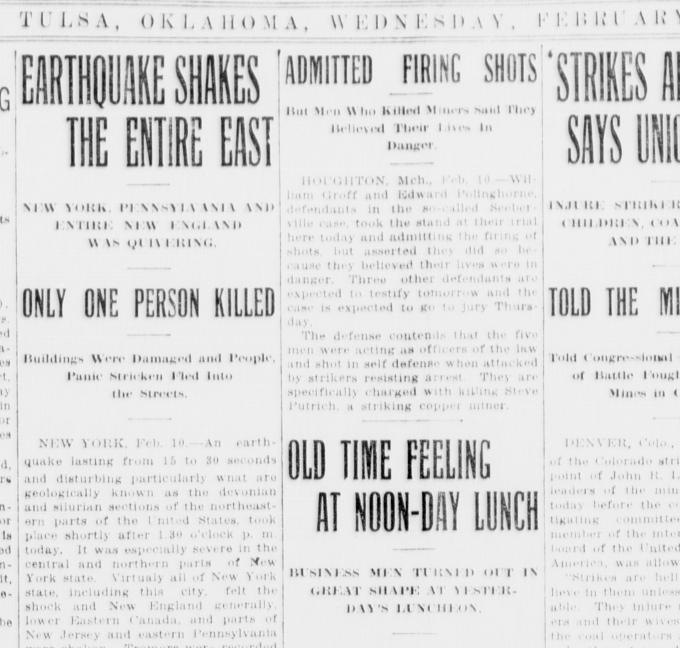|
Moderated by NW Okie! |
Volume 16 , Issue 62014Weekly eZine: (366 subscribers)Subscribe | Unsubscribe Using Desktop... |
100 Years Ago Today - 11 February 1914

One hundred years ago today, 11 February 1914, Wednesday, we might read in The Tulsa Daily World, about the "Earthquake Shakes the Entire East." New York, Pennsylvania and the entire New England was quivering on February 10, 1914, with only one person was killed and buildings damaged and people panic stricken, fleeing into the streets on that day, one hundred years ago.
New York, Feb. 10 (1914) � An earthquake lasting from 15 to 30 seconds and disturbing what were geologically known as the devonian and silurian sections of the northeastern parts of the United States, too place shortly after 1:30pm, February 10, 1914. It was especially severe in the central and northern parts of New York State. Virtually all of New York state, including the city, felt the shock and New England generally, lower Eastern Canada, and parts of New Jersey and eastern Pennsylvania were shaken. Tremors were recorded as far south as Washington and as far west as St. Louis.
At Albany the shock was severe enough to shake pictures from the walls of the capitol and at Binghamton a laborer was killed by the caving in of a trench in which he was working. At Fort Plain the heavy doors of a bank vault shook under the influence of the quake and from other parts of the state the falling of chimneys, swaying of houses and destruction of fragile objects was reported.
In New York City the preliminary tremor was felt at 1:35:15 at 1:35:45 the shock had reached its maximum intensity and at 1:37:30 the movement subsided altogether, making the total duration of the quake two and one quarter minutes, as given by the seismograph. The period in which the shock was perceptible by man was from 10 to 30 seconds and started in a majority of cases about 1:35.
So far as known that day the movement was from northwest to southeast, with the boundary lines of the territory affected converging to a point in the Atlantic.
The initial movement was at points near the upper Atlantic seaboard about 1:35, and extended to placers in the Northern parts of New York state about three minutes later, reaching Albany at 1:38, Rochester at 1:37 and Watertown at 1:39.
From points between these cities the movement was reported to have taken place between 1:34 and 1:37. No seismographic records being obtainable from these localities the time given in these cases deals with the moment when the shock was felt.
According to Dr. Edmund O. Hovey, curator of Geology of the American Museum of Natural History, the character of the record left by the seismograph in his institution showed that the movement of the quake was not attended by great lateral oscillations. Slight tremors were registered on his instrument at irregular intervals and throughout the last 24 hours slight disturbances were recorded their general character indicating that the movement was slight and entirely local.
Before that day, the last earthquake registered by the seismograph of the American Museum took place on November 8, 1912 and occurred in Alaska. The vibrations then were twice as great as those made in 1914 in New York. The last earthquake felt in New York took place in the territory of Charleston, SC, in 1886. IN 1884 a general disturbance took place over the greater part of the area affected on that day in February, 1914.
| View or Add Comments (0 Comments)
| Receive
updates ( subscribers) |
Unsubscribe
| © . Linda Mcgill Wagner - began © 1999 Contact Me | |
